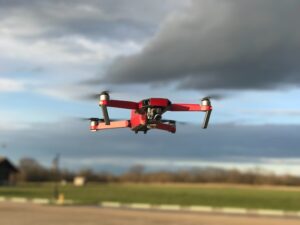
This morning in Las Vegas, the Commercial UAV keynote address was an open conversation with the FAA, moderated by Commercial Drone Alliance Executive Director Lisa Ellman.
At Commercial UAV Expo, the FAA has been present and available: at the booth, in sessions, and on stage. Following the news that the Biden administration has officially nominated FAA veteran Mike Whitaker to the top position at the agency, FAA representatives Jeffrey Vincent, Executive Director for the Unmanned Aircraft Systems (UAS) Integration Office in Aviation Safety (AVS), and Brandon Roberts, Executive Director, Office of Rulemaking took the stage to address the drone industry’s pressing questions.
“It’s a New Day” at the FAA

Jeffrey Vincent responded to a question about the pace of drone integration by recognizing that the agency has struggled to respond to the drone industry in the past. Vincent says that the agency is making major changes, however, to streamline their processes. “We acknowledge that there certainly have been challenges… but it’s a new day,” he said. “Drones are here to stay, and we all understand that…. We understand the need for a regulatory process, and we’re trying to get there as fast as we can.”
Brandon Roberts agreed, commenting that a permanent FAA Administrator will help the agency make substantive progress. “We’ve got a team together now, and having a permanent leader will be a big assist in moving things forward. …Nobody is more frustrated by how long rulemaking takes than I am,” he said. “…We want to go quickly, we have the team onboard that wants to move forward.”
Both representatives agree that the FAA has at times been stymied by a lack of interagency agreement, unable to move forward due to concerns from DOJ and security agencies. “Our security partners highlighted concerns that weren’t addressed [in rulemaking]- and that took us several years,” said Roberts. Now, Roberts says that the agency is coordinated with other government partners and are addressing security and societal concerns up front. Remote ID, Roberts said, is a foundational part of a security framework.
BVLOS Rule, BVLOS Waivers
Waivers and Summary Grants

Roberts explained that the recent authorizations for BVLOS Flight – Phoenix Unmanned, UPS Flight Forward, and uAvionix – were strategically chosen to represent broad use cases. The agency hopes to use these waivers to get to a place of summary grants, where companies can look at previous awards and use the limitations and conditions as a template for their own ConOps. “Figuring out the limitations is what takes the time. But once we can start saying ‘the relief that you are seeing looks very similar to relief that we’ve already granted’ we can [use] summary grants,” said Roberts. “Our goal is collecting data and setting the appropriate precendents to be ready for a rule.” Roberts commented that a fourth applicant for BVLOS relief, Zipline drone delivery, may be the first summary grant: based on the UPS Flight Forward authorization.
When Will We See a BVLOS Rule (Part 108)?
However streamlines, authorizations are still only an interim step to a BVLOS rulemaking. Former FAA Administrator Steve Dickson announced the BVLOS Advisory Rulemaking Committee (ARC) in June of 2021: the committee delivered its recommendations in March of 2022. While a Notice of Proposed Rulemaking (NPRM) was anticipated by the end of last year, the agency now says it is aiming for implementation of a rule in 2025.
“Part 108 is very visionary – that’s made it difficult,” said Roberts. “We’re looking for August of 2024 [for an NPRM], and then we’ll have a comment period – we expect there will be a lot of comments… That will get us to a 2025 timeline for a rule.”
Unmanned traffic management (UTM) and deconfliction are just two of the concepts that the FAA must consider as part of routine operations beyond visual line of sight (BVLOS). “Two things that I’ve always said go hand in hand: making sure that drones don’t run into drones, and making sure that drones don’t run into manned aircraft,” says Vincent. “What is tactical deconfliction going to look like? What does actual true separation look like? All of those things are being considered as we look at Part 108.”
“Probably from industry’s point of view, we’re not moving fast enough… but as we look at these challenges, it seems like tomorrow.”
Remote ID: Relief from the September 16 Deadline
Yesterday, the FAA’s David Boulter promised that the industry would see “relief” for the Remote ID deadline of September 16. When asked for clarification, Roberts did not provide more guidance on what the relief would look like. He explained that while the FAA recognizes the difficulties in complying with the deadline, they also don’t want to penalize those manufacturers and ecosystem partners that worked to meet it.
“We recognize there have been massive supply chain issues,” Roberts said. “There was also a delay in getting the manufacturing specs, and with the FAA accepting the standards. We recognize that it’s probably appropriate not to shut down operations in a week… But we also have the promises that we made to our security partners, who are interested in keeping momentum going. That’s the needle we’re threading. But we do want to make sure that compliant operators who simply can’t get modules won’t be punished.”
Throughout the conversation, the FAA stressed that they are committed to drone integration and to streamlining processes and procedures to help companies deploy uncrewed systems at scale.
“We see an amazing potential for drones,” said Roberts. “We want to enable it.”
Read more:
- BREAKING: Mike Whitaker Nominated to Top Spot at FAA
- FAA Issues BVLOS Exemptions for uAvionix, UPS Flight Forward: Why These are Different
- FAA on What’s Next for Drone Integration, RID Relief: From the Floor of Commercial UAV Expo
- FAA Grants Phoenix Air Unmanned Waiver for BVLOS Flight with Swiss Drones Uncrewed Helicopter
Miriam McNabb is the Editor-in-Chief of DRONELIFE and CEO of JobForDrones, a professional drone services marketplace, and a fascinated observer of the emerging drone industry and the regulatory environment for drones. Miriam has penned over 3,000 articles focused on the commercial drone space and is an international speaker and recognized figure in the industry. Miriam has a degree from the University of Chicago and over 20 years of experience in high tech sales and marketing for new technologies.
For drone industry consulting or writing, Email Miriam.
TWITTER:@spaldingbarker
Subscribe to DroneLife here.